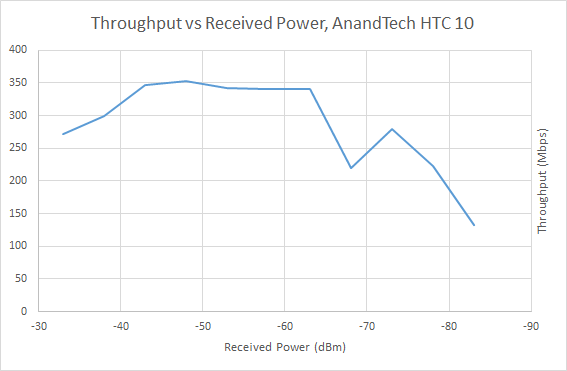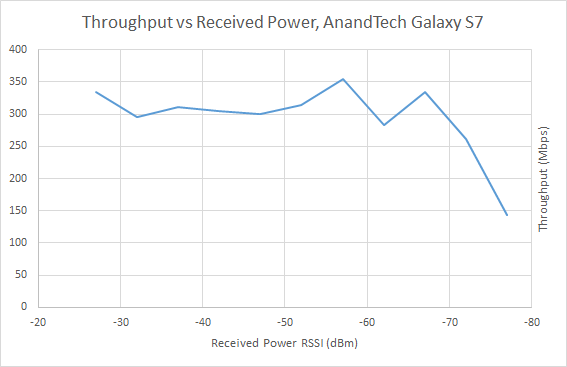The HTC 10 Review
by Joshua Ho on September 19, 2016 8:00 AM ESTWiFi Performance with Ixia IoT
As previously discussed, RF testing has always been a major unknown to some extent because environmental factors make it extremely difficult to tell exactly what is going on with the system. I don’t think it really needs to be said but previous reviews and any controversy regarding the quality of RF has always lead to a ring of confusion and back and forth with no clear-cut answers, at least in the public domain. The Transformer Prime and Pixel C reception issues have all been cases where I’ve seen a lot of confusion over whether a problem really existed in the hardware, software, or with the end user.
Most people really don’t have any understanding of how wireless transmission works, probably because it’s not really something you can see. As far as I know, no one is capable of seeing radio waves, even at high frequencies like 60 GHz. Of course, the problem is that for quite some time our testing was also not really ideal for seeing the quality of an RF implementation. While iPerf does provide some useful data, free space testing means that we’re dealing with channel conditions that inherently cannot be controlled. As a result, the only sensible test we could do with iPerf was focus on maximum throughput in the best conditions we could provide. The only thing that this can highlight is the upper bound of efficiency for WiFi due to the carrier sense multiple access scheme in most cases, and rarely detects a whole class of problems that affect user experience on WiFi.
In order to test these things we’ve moved to using a proper testing system that is actually used by at least a few OEMs today, namely Ixia IoT. While we discussed the possibilities for testing, at this time due to the RF isolation chamber used we are limited to AP simulation only, so we can’t properly simulate clients in the channel without restricting ourselves to a single spatial stream for both the AP and client. This wouldn’t be a very useful test if set up in this manner as most devices today that we’re testing have support for two spatial streams, and many routers have three or even four spatial streams at this point.
The first set of results we can talk about that will be of interest is rate vs range. This is a fairly simple test at a conceptual level, as it simply tries to see how well a device can maintain its performance in the face of reducing signal to noise ratio for a given modulation and coding scheme. This is a good high level test of how well a device can maintain a connection as reception degrades. In this test the HTC 10 had an initial RSSI of -28 dBm while the GS7 was at -21 dBm and the iPhone 6s at -22 dBm, which allows us to calculate the path loss and determine the RSSI as a function of the transmit power.
The results of this test are interesting to say the least. Off the bat, every device had different RSSIs measured, so this meant that everything had different levels of path loss. The HTC 10 seemed to have the most path loss, while the Galaxy S7 and iPhone 6s were functionally identical. However it looks like RSSI is really an insufficient metric here because while the iPhone 6s was able to reach maximum throughput using NSS 2 MCS 8, the HTC 10 and Galaxy S7 did its best at NSS 2 MCS 4 or 5. I suspect this may be just due to placement as device positioning strongly affects MIMO as receive-side spatial correlation reduces the gains that MIMO can provide. Regardless, the HTC 10 somehow manages to beat the Galaxy S7 through much of the curve, but for some reason suffers from a reduction in throughput at higher transmit power. It's worth mentioning though that this test doesn't allow for testing of antenna gain or similar tests. Given various levels of futzing about with the device positioning in the test chamber I'm fairly confident that the Galaxy S7 is consistently better with regard to path loss, so even if it doesn't perform as well at a given RSSI it tends to have a higher RSSI than the HTC 10 by about 5 dBm which is fairly significant. I'm hoping to get some true antenna efficiency measurements with 3D plots in the near future so we can really give some real data on everything relevant here but for now this test highlights fairly well how WiFi performance varies.
Finally, the other test that we can run at this time is the roaming latency test, which tests how well a device can hop from one access point to another as the received transmit power rises and falls. If you ever rely on WiFi to work as you walk around any building larger than a single apartment unit, you’re going to feel the effects of high roaming latency as VOIP calls or any real-time network application will either experience interruption or drop altogether if roaming is not implemented properly.

Like the Galaxy S7, the HTC 10 really struggles with WiFi roaming as it seems almost universal that Android OEMs aren't really paying attention to anything that we don't test. The HTC 10 tended to not fail handover as often as the Galaxy S7 with only one failure out of 64 trials and fairly consistent latency around 110ms though. This is a bit of a surprise considering that the HTC 10 is generally considered in the broader discourse to have worse WiFi across the board compared to the Galaxy S7. Considering how much smaller HTC is this is really kind of strange to see. Just about anything will outperform the Pixel C though. Either way, HTC still should improve here, especially when considering how most schools and offices need good WiFi to make up for areas with cellular coverage gaps.













183 Comments
View All Comments
asfletch - Thursday, September 22, 2016 - link
Preach! Removable battery is big reason why I narrowed my choices recently to Note 4 or LG G5/V10, and only the fear of bootlooping (again a longevity issue, seems to happen to many people after several months of ownershup) put me off the LGs. I will only buy sealed-battery phones in future if I absolutely have to, and I would love to know how hard it'd be to change their batteries.Impulses - Thursday, September 22, 2016 - link
1. Agreed... But I can easily imagine logistical reasons why AT isn't allowed to open (and potentially destroy) review samples or personally bought devices, so we'll probably have to find this info elsewhere. I'm glad my N5 was easy to open even tho I never thought I'd keep it for 3 years.2. This is subjective, how hard is it to occasionally do some cleanup? Yeah, I know people actually toss phones over things as simple as full storage but c'mon, this is AT. I can see how a couple of comments about SD removal would be useful, tho I rarely took mine out when I had phones with them (specially after USB OTG and faster Wi-Fi came of age), phone has never been my primary camera either tho.
3. This is actually way too much of a moving target, and Samsung has actually been amongst the best at keeping non-carrier hobbled flagship models updated. HTC has probably been more consistent if you go farther back than the last 2-3 years tho... AT's forte has never been on the software side anyway.
4. Even more of a moving target with different carriers imposing different policies... And probably less relevant to the mass market. I don't think having a rooted Android device is nearly as attractive as it used to be, various drivers issue tend to make user/dev ROMs a dice roll when you're talking about unsupported Android versions.
If you care that much about that stuff you'll either research it at a place like Xda or you'll just get a Nexus, IMO. FWIW I think HTC still has far more user friendly policy regarding bootloader unlock than Samsung does.
AT phone reviews have always seemed to straddle an enthusiast/mass market line... They dive deep into hardware but only so much as in how it directly affects the user, and I don't think any big time site will ever cover things like how easy it is to repair, mod, etc. Just the nature of the beast, it's post because of the manufacturer relationships but also logistics. There's places like iFixit, XDA, and forums for that...
Zoomer - Thursday, September 22, 2016 - link
The SD tray is similar to the nanoSIM tray. Use a paperclip. It's more of a install once and forget kind of thing. Just pop in a 128 or 256 fast SD and forget about it. Far easier to transfer files by connecting a USB cable, which incidentally charges it.sevenmack - Friday, September 30, 2016 - link
Additionally, on the matter of two MicroSD ports: Most people barely use the one they have, often using a 32gb or 64gb card that is plenty for them. Enthusiasts such as myself would love two MicroSD ports, but I would also rather have a 500gb MicroSD card that would work for all my needs.As for teardowns to see how easy it is to replace a battery: Again, most people (including many enthusiasts) would never bother doing that. They would just buy another phone when the two-year update period comes up. Besides, iFixit provides ample enough information on that.
Fidelator - Monday, September 26, 2016 - link
You should be hired for this site, your thoughts are above and beyondVagabondjonez - Thursday, October 6, 2016 - link
I definitely agree with you 👍eclectech - Wednesday, September 21, 2016 - link
I've had my HTC 10 for months but I learned a lot reading this review. Thanks to your review, I also disabled Chrome and Google Photos, once I found the APKs for HTC Internet and HTC Gallery.Gunbuster - Wednesday, September 21, 2016 - link
Let me just type this out: Six.Hundred.DollarsJust got a BLU R1 HD today. $60, the end of ridiculous phone prices is nearing the end. It's not sustainable. I'm a techie and this phone is good enough. What makes a $600+ phone 10 times better?
ACM.1899 - Thursday, September 22, 2016 - link
Most buyers aren't techie....most of them are 15-30 years old that want to play HD games, watch FHD videos, listen to hq music...they want the best (based on Media or Gsmarena) and don't care that much about the money...they go to a store and all they can see is SAMSUNG and APPLE or let's say huawei...huawei used to be cheap, but now?...not much.
i think the only factor that would make a phone 10 times better (for "ordinary" buyers) is that it lasts 10 times(or whatever time that compensate the money).
look at HTC HD2 ,recently i saw one that could run Android 7...but NOT that good or smooth or enough ram left to run something else and it's a 7 years old phone. and we know that those who flash a custom rom or even root their phone is nothing compared to "ordinary" buyers.
btw in some countries you're stuck with whatever your carriers sell you.
ACM.1899 - Thursday, September 22, 2016 - link
And let's not forget about "Capitalism"